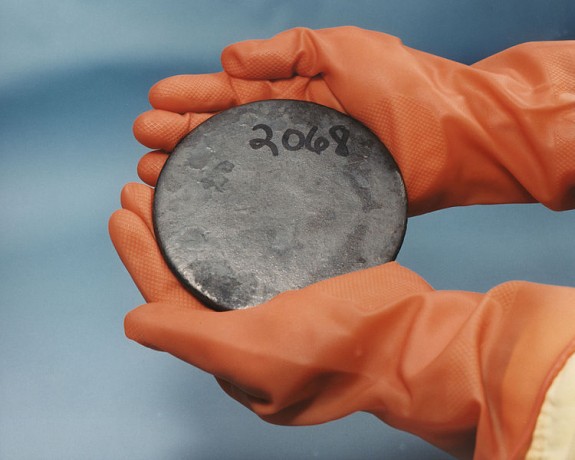This Weird New Chemical Can Pull Uranium Out of the Ocean
A highly-selective new compound can pull uranium right out of the ocean water

A disk of enriched uranium. Photo: U.S. Department of Energy / Wikimedia Commons
The ocean is full of uranium. Well, not really “full.” The concentration of dissolved uranium in seawater is around three parts per billion: for every billion molecules of water, salt, dead fish bits and whatever else makes up a scoop of sea water, three of those atoms will be uranium. But the absolutely massive size of the ocean means that there is still a lot of uranium floating around out there, most often tied up with a pair of oxygen atoms to form the dissolved compound uranyl.
Scientists have long wanted to extract this uranium for use in nuclear power plants. “The world’s oceans hold nearly 1,000 times more uranium than all known land-based sources,” says Chemical and Engineering News. “The total, an estimated 4 billion metric tons, could supply the nuclear power industry’s fuel needs for centuries, even if the industry grows rapidly.”
Plucking uranium out of the sea would likely be much better for the environment than mining it from the ground. But, as you can imagine, getting a few lonely atoms from a pool of billions is a difficult and expensive task.
According to C&EN, scientists working with metal-organic frameworks have developed a new type of material that can latch on to uranium floating in sea water. These frameworks are a relatively new class of compounds that have captivated chemists in recent years for their ability to selectively attract and bind on to very specific target chemicals. The new compound is around four times better than the previous best bet for trapping dissolved uranium.
And aside from putting the new metal-organic framework to work sifting the ocean waters for uranium, tweaks to the compound could theoretically also offer a way to help clean-up efforts during radioactive leaks or other situations where super-selective chemical nets would be useful.
More from Smithsonian.com:
/https://tf-cmsv2-smithsonianmag-media.s3.amazonaws.com/accounts/headshot/smartnews-colin-schultz-240.jpg)
/https://tf-cmsv2-smithsonianmag-media.s3.amazonaws.com/accounts/headshot/smartnews-colin-schultz-240.jpg)